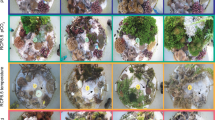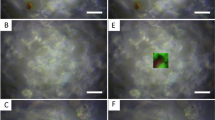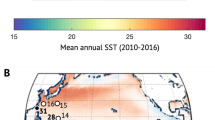Abstract
Rising anthropogenic CO2 in the atmosphere is accompanied by an increase in oceanic CO2 and a concomitant decline in seawater pH (ref. 1). This phenomenon, known as ocean acidification (OA), has been experimentally shown to impact the biology and ecology of numerous animals and plants2, most notably those that precipitate calcium carbonate skeletons, such as reef-building corals3. Volcanically acidified water at Maug, Commonwealth of the Northern Mariana Islands (CNMI) is equivalent to near-future predictions for what coral reef ecosystems will experience worldwide due to OA. We provide the first chemical and ecological assessment of this unique site and show that acidification-related stress significantly influences the abundance and diversity of coral reef taxa, leading to the often-predicted shift from a coral to an algae-dominated state4,5. This study provides field evidence that acidification can lead to macroalgae dominance on reefs.
This is a preview of subscription content, access via your institution
Access options
Subscribe to this journal
Receive 12 print issues and online access
$209.00 per year
only $17.42 per issue
Buy this article
- Purchase on Springer Link
- Instant access to full article PDF
Prices may be subject to local taxes which are calculated during checkout




Similar content being viewed by others
References
Feely, R. A. et al. Impact of anthropogenic CO2 on the CaCO3 system in the oceans. Science 305, 362–366 (2004).
Fabry, V. J., Seibel, B. A., Feely, R. A. & James, O. C. Impacts of ocean acidification on marine fauna and ecosystem processes. ICES J. Mar. Sci. 65, 414–432 (2008).
Langdon, C. & Atkinson, M. Effect of elevated p CO 2 on photosynthesis and calcification of corals and interactions with seasonal change in temperature/irradiance and nutrient enrichment. J. Geophys. Res. 110, C09S07 (2005).
Hoegh-Guldberg, O. et al. Coral reefs under rapid climate change and ocean acidification. Science 318, 1737–1742 (2007).
Connell, S. D., Kroeker, K. J., Fabricius, K. E., Kline, D. I. & Russell, B. D. The other ocean acidification problem: CO2 as a resource among competitors for ecosystem dominance. Phil. Trans. R. Soc. B 368, 20120442 (2013).
Reaka-Kudla, M. L. in Biodiversity II (eds Reaka-Kudla, M. L., Wilson, D. E. & Wilson, E. O.) Ch. 7, 83–108 (Joseph Henry Press, 1997).
Moberg, F. & Folke, C. Ecolgoical goods and services of coral reef ecosystems. Ecol. Econ. 29, 215–233 (1999).
Enochs, I. C. et al. Ocean acidification enhances the bioerosion of a common coral reef sponge: Implications for the persistence of the Florida Reef Tract. Bull. Mar. Sci. 91, 271–291 (2015).
Eyre, B. D., Andersson, A. J. & Cyronak, T. Benthic coral reef calcium carbonate dissolution in an acidifying ocean. Nature Clim. Change 4, 969–976 (2014).
Johnson, M. D., Price, N. N. & Smith, J. E. Contrasting effects of ocean acidification on tropical fleshy and calcareous algae. PeerJ 2, e411 (2014).
Diaz-Pulido, G., Gouezo, M., Tilbrook, B., Dove, S. & Anthony, K. R. High CO2 enhances the competitive strength of seaweeds over corals. Ecol. Lett. 14, 156–162 (2011).
Kroeker, K. J., Micheli, F. & Gambi, M. C. Ocean acidification causes ecosystem shifts via altered competitive interactions. Nature Clim. Change 3, 156–159 (2012).
Jokiel, P. L. et al. Ocean acidification and calcifying reef organisms: A mesocosm investigation. Coral Reefs 27, 473–483 (2008).
Shaw, E. C., McNeil, B. I. & Tilbrook, B. Impacts of ocean acidification in naturally variable coral reef flat ecosystems. J. Geophys. Res. 117, C03038 (2012).
Manzello, D. P. et al. Galápagos coral reef persistence after ENSO warming across an acidification gradient. Geophys. Res. Lett. 41, 9001–9008 (2015).
Crook, E. D., Cohen, A. L., Rebolledo-Vieyra, M., Hernandez, L. & Paytan, A. Reduced calcification and lack of acclimatization by coral colonies growing in areas of persistent natural acidification. Proc. Natl Acad. Sci. USA 110, 11044–11049 (2013).
Shamberger, K. E. F. et al. Diverse coral communities in naturally acidified waters of a Western Pacific reef. Geophys. Res. Lett. 41, 499–504 (2014).
Martin, S. et al. Effects of naturally acidified seawater on seagrass calcareous epibionts. Biol. Lett. 4, 689–692 (2008).
Hall-Spencer, J. M. et al. Volcanic carbon dioxide vents show ecosystem effects of ocean acidification. Nature 454, 96–99 (2008).
Kroeker, K. J., Gambi, M. C. & Micheli, F. Community dynamics and ecosystem simplification in a high-CO2 ocean. Proc. Natl Acad. Sci. USA 110, 12721–12726 (2013).
Kerfahi, D. et al. Shallow water marine sediment bacterial community shifts along a natural CO2 gradient in the Mediterranean Sea off Vulcano, Italy. Microb. Ecol. 67, 819–828 (2014).
Milazzo, M. et al. Ocean acidification impairs vermetid reef recruitment. Sci. Rep. 4, 1–7 (2014).
Fabricius, K. E. et al. Losers and winners in coral reefs acclimatized to elevated carbon dioxide concentrations. Nature Clim. Change 1, 165–169 (2011).
Inoue, S., Kayanne, H., Yamamoto, S. & Kurihara, H. Spatial community shift from hard to soft corals in acidified water. Nature Clim. Change 3, 683–687 (2013).
Marubini, F., Barnett, H., Langdon, C. & Atkinson, M. J. Dependence of calcification on light and carbonate ion concentration for the hermatypic coral Porites compressa. Mar. Ecol. Prog. Ser. 220, 153–162 (2001).
Baker, A. C., Glynn, P. W. & Riegl, B. Climate change and coral reef bleaching: An ecological assessment of long-term impacts, recovery trends and future outlook. Estuar. Coast. Shelf Sci. 80, 435–471 (2008).
Hurd, C. L. Water motion, marine macroalgal physiology, and production. J. Phycol. 36, 453–472 (2000).
Iguchi, A. et al. Effects of acidified seawater on coral calcification and symbiotic algae on the massive coral Porites australiensis. Mar. Environ. Res. 73, 32–36 (2012).
van Woesik, R., Sakai, K., Ganase, A. & Loya, Y. Revisiting the winners and the losers a decade after coral bleaching. Mar. Ecol. Prog. Ser. 434, 67–76 (2011).
Johnson, V. R., Russell, B. D., Fabricius, K. E., Brownlee, C. & Hall-Spencer, J. M. Temperate and tropical brown macroalgae thrive, despite decalcification, along natural CO2 gradients. Glob. Change Biol. 18, 2792–2803 (2012).
McCook, L. J. Macroalgae, nutrients and phase shifts on coral reefs scientific issues and management consequences for the Great Barrier Reef. Coral Reefs 18, 357–367 (1999).
Albright, R., Mason, B., Miller, M. & Langdon, C. Ocean acidification compromises recruitment success of the threatened Caribbean coral Acropora palmata. Proc. Natl Acad. Sci. USA 107, 20400–20404 (2010).
Doropoulos, C., Ward, S., Diaz-Pulido, G., Hoegh-Guldberg, O. & Mumby, P. J. Ocean acidification reduces coral recruitment by disrupting intimate larval–algal settlement interactions. Ecol. Lett. 15, 338–346 (2012).
Sasaki, H., Kataoka, H., Murakami, A. & Kawai, H. Inorganic ion compositions in brown algae, with special reference to sulfuric acid ion accumulations. Hydrobiologia 512, 255–262 (2004).
Disalvo, L. H., Randall, J. E. & Cea, A. Stomach contents and feeding observations of some Easter Island fishes. Atoll Res. Bull. 548, 1–22 (2007).
Program developed for CO2 system calculations (ORNL/CDIAC, 1998)
Mehrbach, C., Culberson, C. H., Hawley, J. E. & Pytkowicz, R. M. Measurement of the apparent dissociation constants of carbonic acid in seawater at atmospheric pressure. Limnol. Oceanogr. 18, 897–907 (1973).
Dickson, A. G. & Millero, F. J. A comparison of the equilibrium constants for the dissociation of carbonic acid in seawater media. Deep-Sea Res. 34, 1733–1743 (1987).
Dickson, A. G. Thermodynamics of the dissociation of boric acid in synthetic seawater from 273.15 to 318.15 K. Deep-Sea Res. 37, 755–766 (1990).
Manzello, D. et al. Remote monitoring of chlorophyll fluorescence in two reef corals during the 2005 bleaching event at Lee Stocking Island, Bahamas. Coral Reefs 28, 209–214 (2009).
Gintert, B. et al. in Proc. 11th Int Coral Reef Symp. 577–581 (Nova Southeastern Univ., 2008).
Kohler, K. E. & Gill, S. M. Coral Point Count with Excel extensions (CPCe): A Visual Basic program for the determination of coral and substrate coverage using random point count methodology. Comp. Geosci. 32, 1259–1269 (2006).
Newcombe, R. G. Two-sided confidence intervals for the single proportion: Comparison of seven methods. Stat. Med. 17, 857–872 (1998).
Helmle, K., Kohler, K. & Dodge, R. The Coral X-Radiograph Densitometry System: Coral XDS (Nova Southeastern Univ., 2015); http://www.nova.edu/ocean/coralxds/index.html
Sokal, R. R. & Rohlf, F. J. Biometry (WH Freeman, 1981).
IBM SPSS Statistics for Windows (2013); http://www-01.ibm.com/software/analytics/spss
GraphPad Prism (2012); http://www.graphpad.com/scientific-software/prism
Acknowledgements
Funding was provided by NOAA’s CRCP and OAP. We are grateful for the support and guidance of F. Rabauliman and F. Castro at BECQ/DCRM, M. Pangelinan and T. Miller at DFW, as well as J. Morgan, J. Tomczuk and D. Okano at NOAA. The crews of the Hi’Ialakai and Super Emerald provided logistic support. F. Forrestal and T. Dearg provided assistance with developing the manuscript.
Author information
Authors and Affiliations
Contributions
I.C.E., D.P.M., E.M.D., G.K., R.O., L.J., C.Y., J.I., S.J., D.B., R.C. and N.N.P. assisted in study design and project planning. I.C.E., E.M.D., G.K., R.O., L.J., C.Y., J.I., C.B.E., M.D.F., S.J., D.B. and S.J.C. collected the data presented herein. I.C.E., D.P.M., E.M.D., G.K., R.O., L.J., J.I., C.B.E., M.D.F., L.V., S.J., D.B., S.J.C., R.C., T.B., Y.E. and N.N.P. worked on data analysis. I.C.E., D.P.M., E.M.D., G.K., R.O., L.J., C.Y., C.B.E., M.D.F., L.V. and N.N.P. contributed to manuscript preparation.
Corresponding author
Ethics declarations
Competing interests
The authors declare no competing financial interests.
Supplementary information
Rights and permissions
About this article
Cite this article
Enochs, I., Manzello, D., Donham, E. et al. Shift from coral to macroalgae dominance on a volcanically acidified reef. Nature Clim Change 5, 1083–1088 (2015). https://doi.org/10.1038/nclimate2758
Received:
Accepted:
Published:
Issue Date:
DOI: https://doi.org/10.1038/nclimate2758
This article is cited by
-
Geochemical evidence of temporal ecosystem photosynthetic plasticity within a pristine coral atoll
Coral Reefs (2024)
-
Sustainable blue economy: Opportunities and challenges
Journal of Biosciences (2024)
-
Coral persistence despite marginal conditions in the Port of Miami
Scientific Reports (2023)
-
Predicting Coral Reef Carbonate Chemistry Through Statistical Modeling: Constraining Nearshore Residence Time Around Guam
Aquatic Geochemistry (2023)
-
The indirect effects of ocean acidification on corals and coral communities
Coral Reefs (2022)



